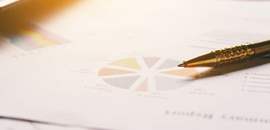- Growth Continues: With government data catching up after the shutdown, alternative indicators point to continued, though slower, economic growth compared to this summer. The recent soft patch stems largely from weaker consumer spending, but we do not view this as an inflection point, as early holiday shopping trends appear encouraging.
- Jobless Expansion: We expect growth to moderate in 2026 as job creation slows amid rising reverse migration. However, productivity gains driven by AI adoption and automation may cushion the impact as firms increasingly substitute capital for labor. A sustained rise in corporate layoff announcements could challenge this “jobless expansion,” though such announcements do not always translate into actual job losses.
- K-shaped Consumer: Consumption remains increasingly bifurcated. Higher income households continue to spend, supported by sustained wage gains and rising asset prices, while lower income consumers face slowing wage growth, credit strain, and persistent inflation. Potential stimulus next year could help, but any economic or financial disruption could quickly destabilize this fragile balance.
- Affordability Crisis: Basic needs, housing, food, and healthcare are increasingly unaffordable. Post-pandemic income gains have not caught up with elevated price levels. Existing home prices are up 60% since 2019, pushing the median first-time homebuyer age to 40 (from 33) and the share of first-time buyers to a record low 21%. Employer provided health insurance premiums have risen 6–7% annually for 25 years. Although policymakers acknowledge the issue, meaningful solutions remain scarce. Left unaddressed, affordability constraints could weigh on long term growth potential.
- 50-year Mortgage: The FHFA has floated 50-year mortgages to ease housing affordability by reducing monthly payments. While longer maturities do lower monthly costs, they also sharply increase total interest paid, slow equity buildup, and, without a meaningful increase in supply, risk pushing home prices even higher. We do not expect the proposal to gain traction and view it more as a signal that the administration is likely to pursue additional measures aimed at lower income households.
- Guardedly Optimistic: Market cycles follow earnings cycles, which in turn follow economic cycles. While we see some risk of softer economic growth, we do not anticipate a contraction. As a result, we remain guardedly optimistic about market prospects heading into 2026.
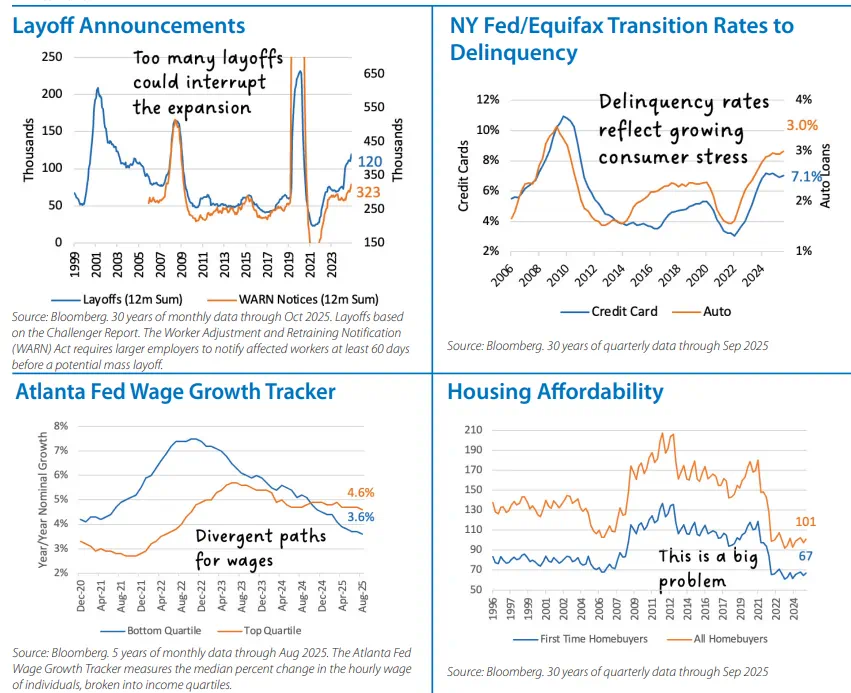
- Remaining Neutral: We maintain a neutral stance on our fixed income allocation. Although declining yields and tighter spreads modestly temper return expectations, bonds continue to serve a critical strategic role as portfolio ballast and a source of stable income.
- High-Quality Bias: We remain tactically overweight investment grade bonds, supported by attractive yields and lower economic sensitivity. Risk-adjusted return prospects compare favorably with recent history. Interest rate sensitive sectors have kept pace with credit sector returns this year, a dynamic that could continue into 2026.
- Watch the Long End: While the belly of the curve has outperformed, we remain cautious on longer duration Treasuries as the spread between intermediate and long term yields has resumed widening. Resilient growth, sticky inflation, elevated risk premia, and persistent structural deficits argue for maintaining a focus on the intermediate portion of the curve.
- Congressional Dysfunction: After the longest government shutdown in U.S. history, Congress reopened by passing a stopgap measure that merely defers key fiscal decisions to January 2026. While short term market impacts from political dysfunction are often limited, the longer term consequences are more detrimental. Persistent gridlock erodes public confidence, dampens business sentiment, weighs on economic momentum, and undermines U.S. credibility, ultimately weakening the foundation for sustained growth.
- Fed Pause Ahead?: The Fed is likely to deliver a third rate cut in December, potentially setting the stage for an extended pause similar to the 2024 policy path. With policymakers heavily dependent on data, a pause allows government indicators time to catch up following recent delays. If the employment backdrop weakens, the Fed retains room to cut further. With policy already nearing neutral, given roughly 3% underlying inflation, and a possible announcement of Chair Powell’s replacement as soon as this month or next, the Fed may prefer a wait-and-see stance heading into the new year.
- Quality as a Safeguard: Even as risk assets rally, investor risk appetite is softening, and confidence could deteriorate quickly. While the timing of a “risk-off” event remain uncertain, the rising probability reinforces the importance of maintaining a high-quality fixed income allocation as a safeguard within diversified portfolios.
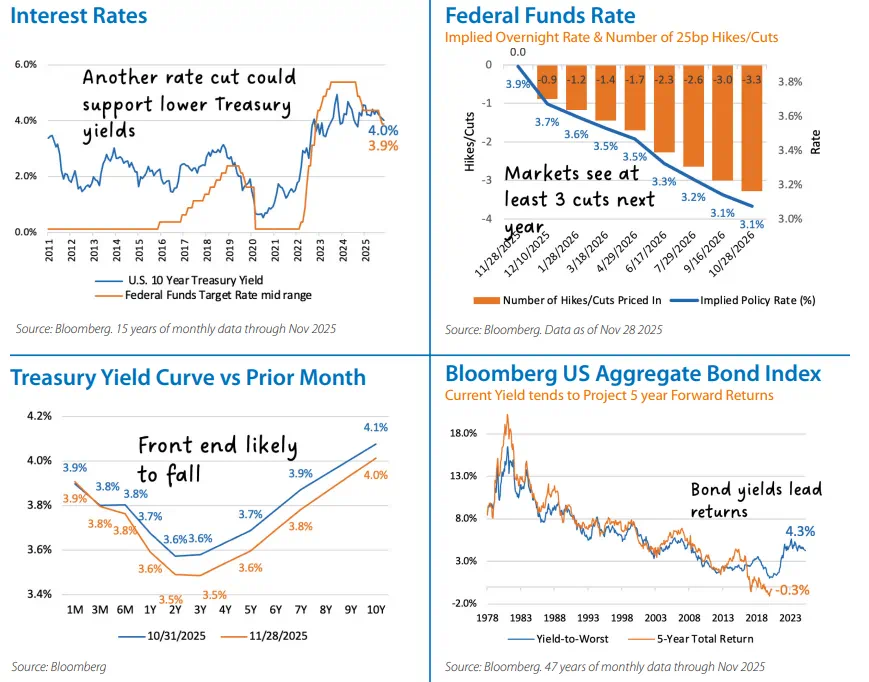
- Cautious on Credit: We remain underweight high yield bonds given tight spreads. That said, the economy’s ongoing resilience, supportive financial conditions, and higher overall index quality reduce the need for an overly defensive stance. Because our strategic allocation begins with a meaningful exposure to below-investment-grade credit, we maintain meaningful exposure despite the tactical underweight.
- Quality Control: Since the Global Financial Crisis, the high yield market has shifted toward higher quality issuers. The Bloomberg High Yield Index now consists of roughly 52% BB-rated bonds and just 12% CCC-rated names. Adjusted for this improved quality mix, spreads may still have modest room to grind tighter if corporate profits and economic growth remain stable.
- Loose Lending Standards: Five years after corporate borrowing surged in the wake of the post-pandemic period, risk tolerance and underwriting discipline may have eroded. Recent headlines involving alleged fraud-related bankruptcies and other disclosures could be early signs of softer lending standards. The key question is whether these issues are isolated or systemic. While we believe confidence in credit conditions may be slowly deteriorating, we view the recent events as idiosyncratic, not indicative of widespread stress.
- Corporate Metrics Sound: Third quarter earnings results were solid. Corporate leverage has edged higher but remains below 2021 levels and interest-coverage ratios remain healthy. Fundamentals should receive continued support from economic growth and incoming stimulus. Additional tailwinds, including net stimulus from OBBBA, fading tariff uncertainty and possible refunds, easing financial conditions, and foreign direct investment – suggest further underpinning for overall credit risk.
- Structural Support: Lower income consumer stress may weigh on select sectors, including consumer discretionary issuers and consumer-oriented asset backed securities. However, post-GFC reforms have strengthened structural protections, offering added resilience against pockets of consumer weakness. Investment managers with strong due diligence and surveillance processes are best positioned to navigate these late-cycle conditions; those under pressure may need to reassess underwriting standards.
- Active Management Essential: With relative yields still attractive, late-cycle dynamics unfolding, and deal activity elevated, credit markets offer both risks and opportunities. This environment reinforces the need for disciplined, active management to identify value and mitigate downside risk.
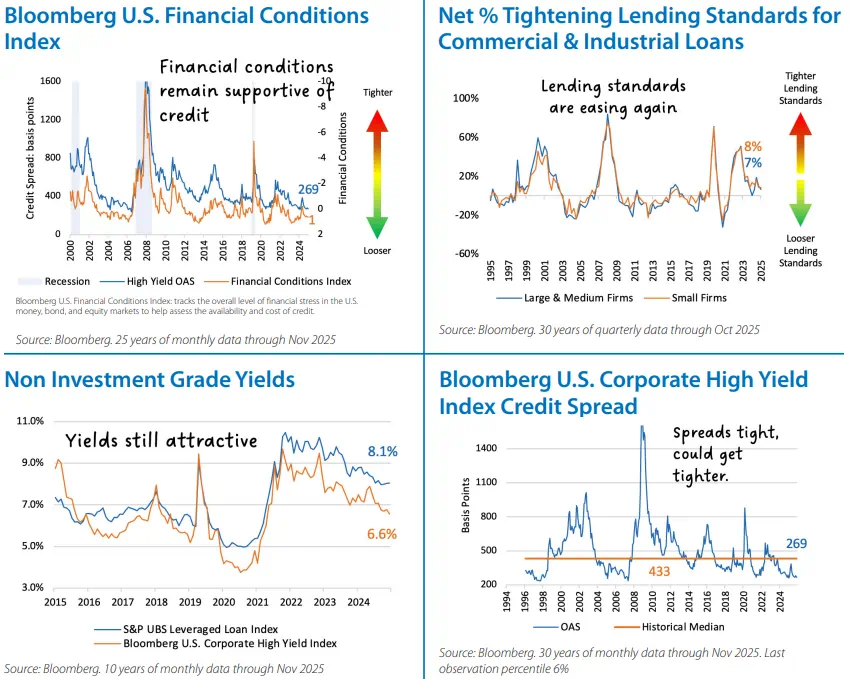
Fixed Income Indexes Characteristics
The Indexes mentioned are unmanaged statistical composites of stock market or bond market performance. Investing in an index is not possible.
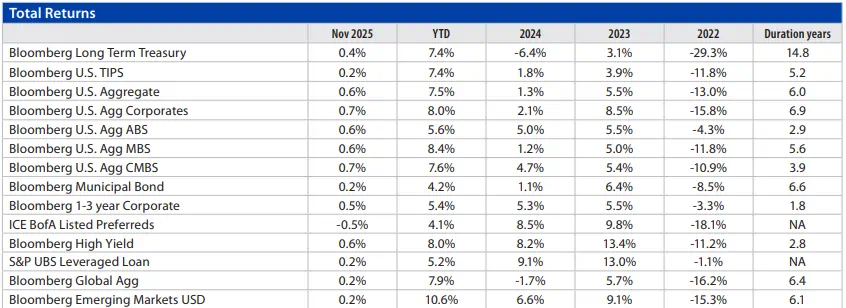
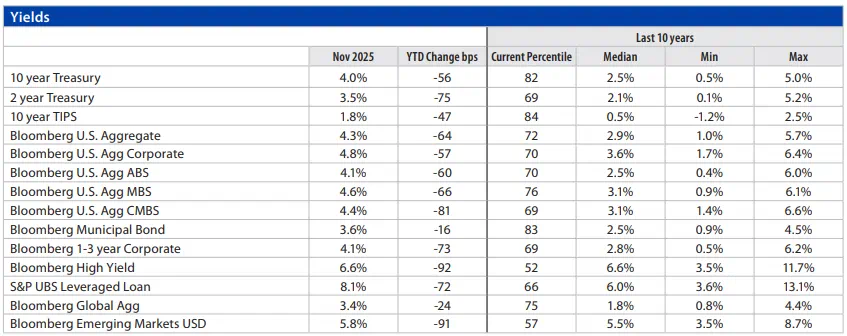

For Index Definitions see: TouchstoneInvestments.com/insights/investment-terms-and-index-definitions
2022 – The Fed embarked on one of its most aggressive tightening paths seen in decades as the inflation rate surged well above their goal. Interest rates rose across all maturities leading to one of the worst years for fixed income returns.
2023 – Inflation fell broadly while the economy grew with the labor market and consumer spending resilient. The Fed paused midyear helping rates and credit spreads fall late in the year and turning returns positive for the year.
2024 – Economic growth continued unabated, driven by consumer spending. Inflation moderated further. The Federal Reserve pause continued until September, after which it cut interest rates three times by a total of 1 percentage point. Bond yields rose in response, resulting in only modest gains for high quality fixed income but better returns for riskier areas of fixed income.
The Touchstone Asset Allocation Committee
The Touchstone Asset Allocation Committee (TAAC) consisting of Crit Thomas, CFA, CAIA – Global Market Strategist, Erik M. Aarts, CIMA – Vice President and Senior Fixed Income Strategist, and Tim Paulin, CFA – Senior Vice President, Investment Research and Product Management, develops in-depth asset allocation guidance using established and evolving methodologies, inputs and analysis and communicates its methods, findings and guidance to stakeholders. TAAC uses different approaches in its development of Strategic Allocation and Tactical Allocation that are designed to add value for financial professionals and their clients. TAAC meets regularly to assess market conditions and conducts deep dive analyses on specific asset classes which are delivered via the Asset Allocation Summary document. Please contact your Touchstone representative or call 800.638.8194 for more information.
A Word About Risk
Investing in fixed-income securities which can experience reduced liquidity during certain market events, lose their value as interest rates rise and are subject to credit risk which is the risk of deterioration in the financial condition of an issuer and/or general economic conditions that can cause the issuer to not make timely payments of principal and interest also causing the securities to decline in value and an investor can lose principal. When interest rates rise, the price of debt securities generally falls. Longer term securities are generally more volatile. Investment grade debt securities which may be downgraded by a Nationally Recognized Statistical Rating Organization (NRSRO) to below
investment grade status. U.S. government agency securities which are neither issued nor guaranteed by the U.S. Treasury and are not guaranteed against price movements due to changing interest rates. Mortgage-backed securities and asset-backed securities are subject to the risks of prepayment, defaults, changing interest rates and at times, the financial condition of the issuer. Foreign securities carry the associated risks of economic and political instability, market liquidity, currency volatility and accounting standards that differ from those of U.S. markets and may offer less protection to investors. Emerging markets securities which are more likely to experience turmoil or rapid changes in market or economic conditions than developed countries.
Performance data quoted represents past performance, which is no guarantee of future results. The investment return and principal value of an investment in the Fund will fluctuate so that an investor’s shares, when redeemed, may be worth more or less than their original cost. Current performance may be higher or lower than performance data given. For performance information current to the most recent month-end, visit TouchstoneInvestments.com/mutual-funds.
Please consider the investment objectives, risks, charges and expenses of the fund carefully before investing. The prospectus and the summary prospectus contain this and other information about the Fund. To obtain a prospectus or a summary prospectus, contact your financial professional or download and/or request one on the resources section or call Touchstone at 800-638-8194. Please read the prospectus and/or summary prospectus carefully before investing.
Touchstone Funds are distributed by Touchstone Securities, Inc.*
*A registered broker-dealer and member FINRA/SIPC.
Touchstone is a member of Western & Southern Financial Group
Not FDIC Insured | No Bank Guarantee | May Lose Value















